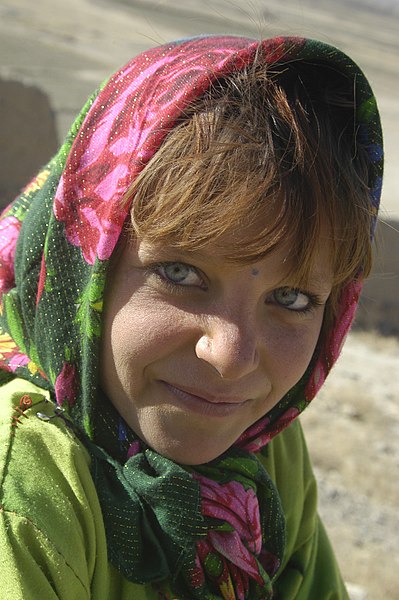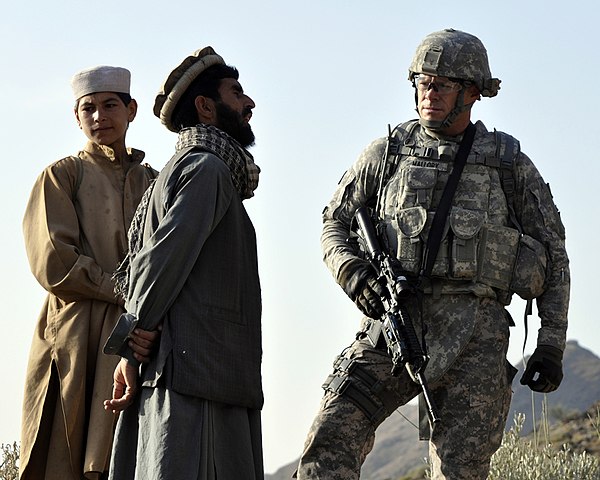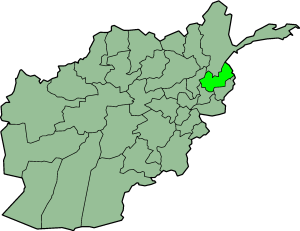
| NURISTANIS
A young Nuristani girl in an orphanage in Kabul, Afghanistan (January 2002) Regions
with significant populations : Nuristan Province, Afghanistan,
Chitral District and Pakistan
Kautiak villagers in Nuristan province with U.S. Navy commander (right) The Nuristanis are an ethnic group native to the Chitral District of northwestern Pakistan and Nuristan Province of northeastern Afghanistan, who speak Indo-Iranian languages, chiefly Nuristani. In the mid-1890s, after the establishment of the Durand Line when Afghanistan reached an agreement on various frontier areas to the British Empire for period of time, Emir Abdur Rahman Khan conducted a military campaign in Nuristan and followed up his conquest with forced conversion of the Nuristanis to Islam; the region thenceforth being known as Nuristan, the "Land of Light". Before their conversion, the Nuristanis practised a form of ancient Hinduism. Non-Muslim religious practices endure in Nuristan today to some degree as folk customs. In their native rural areas, they are often farmers, herders, and dairymen.
The Nuristanis are distinguished from the Kalash and a segment of the Kho people of Chitral by their adoption of Islam, territory within Afghanistan, and consolidation with other Afghans. The Nuristan region has been a prominent location for war scenes that have led to the death of many indigenous Nuristanis. Nuristan has also received abundance of settlers from the surrounding Afghanistan regions due to the borderline vacant location.
Pre-Islamic
religion :
"Before their conversion to Islâm the Nuristânis practiced a form of ancient Hinduism, infused with accretions developed locally".
They acknowledged a number of human-like deities who lived in the unseen Deity World (Kâmviri d'e lu; cf. Sanskrit dev lok).
Certain deities were revered only in one community or tribe, but one was universally revered as the creator: the Hindu god Yam Râj called imr'o in Kâmviri. There is a creator god, appearing under various names, as lord of the nether world and of heaven: Yam Raj, or Mar ('death', Nuristani), or Dezau (dezáw) whose name is derived from Indo-European *dheig'h i.e. "to form" (Kati Nuristani dez "to create", CDIAL 14621); Dezauhe is also called by the Persian term Khodaii. There are a number of other deities, semi-gods and spirits. The Kalash pantheon is thus one of the few living representatives of Indo-European religion.
They believed in many deities, whose names resembled those of Iranian and old Vedic sources. There was a supreme deity named Mara or Imra, plus a multitude of lesser gods and goddesses known locally as Mandi or Moni, Wushum or Shomde, Gish or Giwish, Bagisht, Indra, Züzum, Disani, Kshumai or Kime etc.
Each village and each clan had its guardian deity, with shamans advising the help-seekers and priests presiding at religious services. The cult centered on the sacrifice of animals, mostly goats.
The area extending from modern Nooristan to Kashmir was known as "Peristan", a vast area containing a host of Nuristani cultures and Indo-European languages that became Islamized over a long period. Earlier, it was surrounded by Buddhist states and societies which temporarily extended literacy and state rule to the region. The journey to the region was perilious according to reports of Chinese pilgrims Fa-hsien and Sung Yun. The decline of Buddhism resulted in the region becoming heavily isolated. The Islamization of the nearby Badakhshan began in the 8th century and Peristan was completely surrounded by Muslim states in the 16th century. The Kalash people of lower Chitral are the last surviving heirs of the area.
The region was called "Kafiristan" because while the surrounding populations were converted to Islam, the people in this region retained their traditional religion, and were thus known as "Kafirs" to the Muslims. The Arabic word "Kufr" means disbelief and the related word "Kafir" means one who does not believe in Islam. Thus "Kafir" here is used to refer to their being non-Muslims; the province was therefore known as Kafiristan. The majority were converted to Islam during Abdur Rahman Khan's rule around 1895. The province is now known as Nuristan and the people as Nuristanis. However, among the rural population many old customs and beliefs like occasional production of wine have continued.
History
:
Nuristanis were formerly classified into "Siah-Posh (black-robed) and "Safed-Posh (white-robed)/Lall-Posh (Red-Robed). Timur fought with and was humbled by the Siah-Posh. Babur advised not to tangle with them. Genghis Khan passed by them.
In 1014, Mahmud of Ghazni attacked them :
Another crusade against idolatry was at length resolved on; and Mahmud led the seventh one against Nardain, the then boundary of India, or the eastern part of the Hindu Kush; separating as Firishta says, the countries of Hindustan and Turkistan and remarkable for its excellent fruit. The country into which the army of Ghazni marched appears to have been the same as that now called Kafirstan, where the inhabitants were and still are, idolaters and are named the Siah-Posh, or black-vested by the Muslims of later times. In Nardain there was a temple, which the army of Ghazni destroyed; and brought from thence a stone covered with certain inscriptions, which were according to the Hindus, of great antiquity.
Timur's
encounter with Katirs/Kators :
Timur's
encounter with Kam Kafirs :
It is notable that Timur does not boast of any killings or imprisonment of the Siah-Poshes as he does for the Katirs and numerous other communities of India proper. Also, he gives no further details of his conflict with the Siah-Poshes in his Tuzak-i-Timuri after this encounter, which clearly shows that the outcome of the fight against the Siah-Poshes was very costly and shameful for Timur.
Other references to these Kafirs are made in the fifteenth and later in sixteenth century during the Mughal period.
In 1839, the Kafirs sent a deputation to Sir William Macnaghten in Jalalabad claiming relationship with the fair skinned British troops who had invaded the country
19th
century scholarship :
Pre-1895
(un-Islamized) Kafir society :
Siah-Posh
sub-divisions :
All Siah-Posh groups of Kafirs are regarded as of common origin. The Siah-Posh Katirs themselves admit of common origin and general relationship to each other. They all have a common dress and customs and they do not speak precisely same language, but the difference in their speech is more a difference of dialect than radical distinction of language. The Kati language or its dialects are spoken by various Siah-Posh communities.
Nicholas Barrington et al. report that the Sped-Posh Kafirs (Waigulis and Presungulis) refer to all Siah-Posh Kafirs (including the Kamoz) as Katirs and regard them of the same stock linguistically and ethnographically.
According to American ethnographer Richard Strands, the Bashgul valley Kafirs have various designations like Kata, Kom, Mumo, Ksto, Bini, Jamco and Jasi etc. But they are also called by other names like Kamtozi/Kantozi, Kamozi, Kam, Katir etc.
While the Siah-Posh Kamtoz Katirs of the lower Bashgul valley are the most numerous, the Siah-Posh Kam or Kamoz/Kamoje Kafirs of the upper Bashgul valley were the most intractable and fierce and to be most dreaded for their military prowess.
Probable
racial origin :
Genetics
:
Tribes :
Nuristan, in light green Most Nuristanis are from the Kata Family and Janaderi Branch. However, there are other Nuristani tribes as well, some of the Kata of Janaderi people live in Ozhor (now Karimabad), Gobor, Buburat, Ayun, Broze and Mastuj. There is a very popular rock associated with this tribe located in Karimabad (Juwara) called kata bont (Kata is the name of the tribe; bont meaning "stone" in the Chitrali language).
The Nuristani do not have a formal tribal structure as the Pashtuns do, however they do designate themselves by the names of the local regions they are from. In total, there are 35 such designations: five from the north–south valleys and 30 from the east–west valley.
Some of these tribes include :
•
Askunu
Source :
https://en.wikipedia.org/ |


